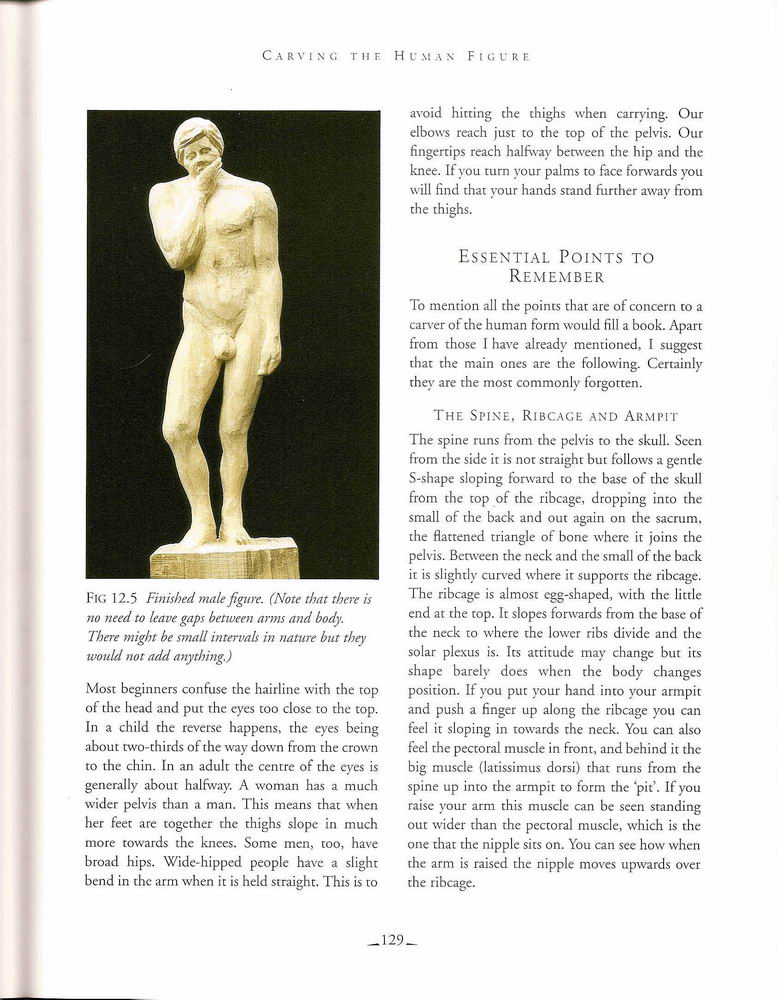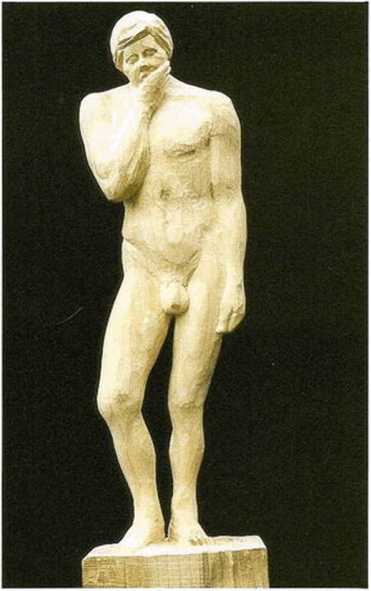essentÊrving±29

C A R v I N O. Tl-IF. H l* M A N F I C, f R F.

Fig 12.5 Finished małe figurę. (Notę that there is no need to leave gaps between arnis and body.
There might be smali interuah in naturÄ™ but they would not add anything.)
Most bcginners confuse the hairline with the top of the head and put the cyes too close to the top. In a child the reverse happens, the eyes being about two-thirds of the way down from the crown to the chin. In an adult the centre of the eyes is generally about halfway. A woman has a much wider pelvis than a man. This means that when her feet are together the thighs slopc in much morÄ™ towards the knees. Some men, too, have broad hips. Wide-hipped people have a slight bend in the arm when it is held straight. This is to avoid hitting the thighs when carrying. Our elbows reach just to the top of the pelvis. Our fingertips reach halfway between the hip and the knee. If you tum your palms to face forwards you will find that your hands stand furcher away from the thighs.
Essential Points TO Remember
To mention all the points that are of concern to a carver of the human form would fili a book. Apart from those I have already mentioned, I suggest that the main ones are the fol Å‚owi ng. Certainly they are the most commonly forgotten.
Thf. Spine, Ribcage and Armpit The spine runs from the pclvis to the skuli. Scen from the sidc it is not straight but follows a gentle S-shape sloping forward to the basc of the skuli from the top of the ribcage, dropping into the smali of the back and out again on the sacrum, the flattened triangle of bonę whcrc it joins the peh is. Between the neck and the smali of the back it is slightly curved where it supports the ribcage. The ribcage is almost egg-shaped, with the little end at the top. It slopes forwards from the base of the neck to where the lower ribs divide and the solar plcxus is. Its attitude may change but its shape barely does when the body changes position. If you put your hand into your armpit and push a finger up along the ribcage you can feel it sloping in towards the neck. You can also feel the pectoral muscle in front, and behind it the big muscle (latissimus dorsi) that runs from the spine up into the armpit to form the ‘pil’. If you raisc your arm this muscle can be seen standing out wider than the pectoral muscle, which is the one that the nipple sits on. You can see how when the arm is raised the nipple moves upwards over the ribcage.
_129 —
Wyszukiwarka
Podobne podstrony:
coal lease. Also, there is no need to pay royalties if minÄ™ gas is vented to the atmosphere to keep
essent?rving?30 E S S E N T l A L W O O I) C A R V I N G T E C H X I Q U E S Fig 12.6 The małe skele
f Fig. 12 Lifting and carrying meat and boxes is frequent. Manuał lifting of 75 kg ocajrs and one ma
f27 d c- orange pink NOTĘ: If there is no letter, leave the space white.T-[biue
Viruses and some bacteria induce IL-12 secretion by dendritic cells that can activated NK cells
1H7 % S> FigurÄ™ 3-7. As these micrographs demonstrate, there is no iniieretu loss
tmta 0 6Hand luggagc Hand luggage (Fig 6) forms part of an historical character. Every individual wo
89472 system 21 21 tain tremendously strong links if others are fragile ? One must admit that it is
essent?rving?22 ESSENTIAL W O O D C A R VIN G T E C H N IQ U E S Fig 1.36 It is possible to use the
essent?rving?59 Car ved Mo u l dix g s Fig 4.12 After the rim ofthe cup has been stabbed in, a chip
essent?rving?84 Essential Woodcarving Techniques Fig 7.7 This is how a piece of card would look if f
essent?rving?31 C a r v i n c; i he Humań Figur f. Fic; 12.7 Muscles at the back of the body Fig 12.
essent?rving?33 C A R VIN G THE HfMAN FIG1R E Fic. 12.13 The clay bead witb most of the muscles. Fig
essent?rving?36 E S S E N T I A L W o O D C A R V ! N G T E C H X i .. Fig 12.19 Edward Greene (khay
więcej podobnych podstron